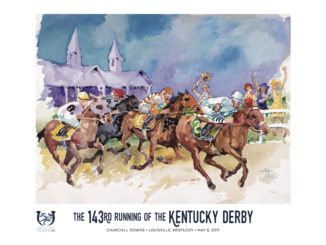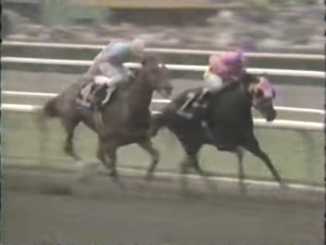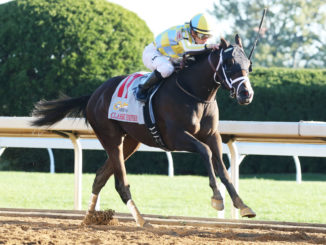
The Stephen Foster Handicap will be run for the the 37th time at Churchill Downs on Saturday. A race born of humble beginnings, the Foster has evolved not only into the premier summertime race for older horses in the Midwest, but also the signature race of the division beyond a mile held between the Dubai World Cup and the boutique meets of Saratoga and Del Mar.
To get a sense of how the Foster’s importance in the racing landscape has changed, it’s best to go back to the beginning. In 1981, the year before the Foster was inaugurated, the New York Handicap Triple (Metropolitan, Suburban, and Brooklyn handicaps) and events at Hollywood Park (Californian, Gold Cup), as they had for some time, attracted the bulk of the nation’s best older horses during the summer months.
Indeed, the Midwest region as a whole was a rather quiet one for the division with three Grade 2 events — the Cornhusker Handicap at Ak-Sar-Ben, the Michigan Mile and One-Eighth Handicap at Detroit, and the Washington Park Handicap at Arlington Park — the only real enticements for horsemen on either coast to send their better handicap stars into the American heartland.
Churchill Downs itself, in that era, was decidedly low-key outside of Kentucky Derby week, with the Chicago-area Arlington the preeminent summertime track in the region. Besides the two Grade 1s (the Derby and the Kentucky Oaks), Churchill’s only other graded stakes at the time were all held during the fall meet, and the Clark Handicap, Falls City Handicap, Kentucky Jockey Club, and Golden Rod were Grade 3 events.
The Clark for years had been the most significant race for older horses held at Churchill, while the main offering at the track’s spring/summer meet for older horses around two turns was the Louisville Handicap. Traditionally run the Saturday after the Derby, the Louisville Handicap was contested at 1 1/16 miles. In 1981, the gross value of the Louisville was $34,450, the equivalent of a mere $92,556 in current dollars.
For the 1982 spring/summer meet, Churchill officials enhanced its stakes offerings for older horses. Presumably in a step to beef up the Kentucky Derby week stakes schedule, the Louisville was moved to the first full week of the meet, its distance increased to 1 1/8 miles and its purse bumped to $50,000-added. Scheduled for June 19 that year was the inaugural Stephen Foster Handicap, named in honor of the 19th century songwriter responsible for “My Old Kentucky Home,” the signature tune for both the commonwealth and the Kentucky Derby.
Also carrying a $50,000-added purse and run at 1 1/8 miles, the first Foster was won by Vodika Collins, trained by Forrest Kaelin. Vodika Collins went on to win the Michigan Mile and One-Eighth later that summer, and in 1983 successfully defended his Stephen Foster title.
“I never ran him in a maiden race,” said Kaelin in a 2010 interview. “His first race, I ran him in an allowance race at Turfway Park (then Latonia) and he won as the favorite. He made nearly $600,000 and that was a lot of money back then.”
The Stephen Foster had its first nationally significant winner for its fourth running in 1985 when Vanlandingham, making only his second start since the previous year’s Kentucky Derby, led wire-to-wire to score by a half-length under Pat Day for trainer Shug McGaughey. Vanlandingham later won the Suburban Handicap and then became the only horse other than five-time Horse of the Year Kelso to win both the Jockey Club Gold Cup and Washington D.C. International on turf in the same year. Vanlandingham was voted the Eclipse Award as champion older male.
The Foster purse was bumped to $100,000-added for 1986, and in 1987 became Churchill’s premier spring/summer meet offering for older horses when the Louisville was transferred to the new Matt Winn Turf Course. The Foster achieved Grade 3 status for the first time in 1988, and in 1991 the Foster commenced a six-race win streak by Black Tie Affair that culminated with a victory in the Breeders’ Cup Classic (also at Churchill) and a Horse of the Year title. In between the Foster and Breeders’ Cup, Black Tie Affair also won those old regional standbys: the Michigan Mile, Cornhusker, and Washington Park. It seemed the Stephen Foster’s time had arrived.
By the mid 1990s, the complexion of the handicap racing calendar was undergoing a radical change. In the Midwest, the Michigan Mile and Cornhusker went defunct, as did their host sites of Ak-Sar-Ben and Detroit Race Course. The old New York Handicap Triple broke up as distance racing and long campaigns were de-emphasized by modern horsemen, and the 1 1/4-mile Suburban Handicap was downgraded from Grade 1 to Grade 2 by the American Graded Stakes Committee.
The Foster, which was increased to $150,000-added in 1994 and elevated to Grade 2 status the following year, would soon be in a prime position to fill a seeming void. With the inauguration of the Dubai World Cup in 1996, it became apparent that U.S. horsemen with prominent World Cup runners were looking for a mid-summer race in which to ease back into the domestic scene, and not necessarily in 1 1/4-mile races like the Suburban or Hollywood Gold Cup. With its non-Derby Week stature and bottom line having risen substantially in the previous decade as host to three Breeders’ Cups (with another one scheduled in 1998), Churchill was in the financial position to have the Stephen Foster step in and fill that void.
For that 1998 renewal, the Foster purse was hiked to $750,000-added and marked the return to action of Silver Charm, the 1997 Derby and 1998 World Cup winner for Bob Baffert. However, under a 127-pound impost, the popular gray and future Hall of Famer fell short against Awesome Again, who carried 14 pounds less but would beat Silver Charm again that November in the Breeders’ Cup Classic over the same track at equal weights.
Classic winner Victory Gallop, third in the 1999 World Cup, turned in a devastating five-length win in his return to action in that year’s Foster en route to champion older male honors. The Baffert-trained Captain Steve won the 2001 World Cup and then ran second in the Foster, but in 2002 Street Cry became the first horse to win both races in the same season. That 2002 Foster was the first run as a Grade 1 event.
In the intervening years, the Stephen Foster winner’s circle has been graced by Horses of the Year Saint Liam and Curlin and Breeders’ Cup Classic winners Blame and Fort Larned. And as the defeats of champions like Mineshaft, Wise Dan, and Will Take Charge suggest, the race remains competitive and difficult to win even for the most decorated of Thoroughbreds.
With a current purse of $500,000, Saturday’s Foster will again be the setting for the return to action of a prominent Dubai World Cup participant, in this case runner-up Gun Runner. The Steve Asmussen-trained colt will be looking for his second career Grade 1 win after taking the Clark last November.
Three horses have previously won the Clark and followed up with a victory the next year in the Stephen Foster: Hopeful Word (1985-86), Saint Liam (2004-05), and Blame (2009-10). The latter two were named champion at the end of the year, something the connections of Gun Runner would obviously like to see happen to their colt.
From an unpretentious start less than 40 years ago the Stephen Foster has become a showcase for champions, both reigning and aspiring, from the post-classic generations. It’s relatively rapid rise and effectiveness at attracting the best Thoroughbreds back to Louisville after their sophomore campaigns lends credence to Churchill Downs’ motto of being the World’s Most Legendary Racetrack®.



